Subscription growth hack (by PayKickstart)
Facebook Group - 3,932 members
Visit Group
Feature creep, just like the name implies, happens slowly and has far reaching consequences.
Most businesses start out wanting to solve a specific problem for a specific customer base.
Over time, they get good at that and realize they can help other people. When they present their solution to those other groups, they have a mixed reaction.
“I like the tool but can you add X,Y, or Z? Then it’d be perfect.”
That’s the beginning of feature creep and the end of an elegant yet simple solution.
This article takes a look at what feature creep is, how to identify it, and ways to manage it before it becomes a problem.
Feature creep, in its most basic form, is the ongoing expansion of a product beyond its original functionality. New features are added, there’s more complexity, and bloat sets in. This is a recurring problem with computer software, games, and electronics.
The challenge with feature creep stems from wanting to please users, make more valuable products, and improve the bottom line. New functions are added to give the appearance of constant development & innovation, to stay competitive, or to in response to user requests.
Every product eventually becomes mature and arrives at the point where there are no more major features to add. The product maker has multiple choices at this point. They can either stop development, continue to incorporate new features (which are often unneeded), or carefully innovate and only add high impact features.
The first option isn’t an option because it can cause problems with retention and increase churn. The second option is much easier because there’s always a new feature that can be added. The third option is the most difficult but the one that’ll yield the greatest positive impact. Instead of catching up, you’re leading the pack with innovation.
One of the most popular pieces of software in the world – Microsoft Word – suffered from feature creep for a long time.

It was unwieldy. 9 out of ten users requested features that were already available because they simply couldn’t find them.
Don’t be Microsoft.
Common reasons for feature creep:
Let’s get something clear right now. Feature creep is almost an inevitable part of building products. You’re influenced by so many different factors including your own vision, customers, and competitors. It’s only natural that you add a feature or two that’s not too useful.
The key to managing feature creep is to keep these instances to the bare minimum and take corrective action when it happens. Here are a few ways to manage feature creep.
This seems like an obvious measure to manage feature creep but it’s not followed nearly as often as people like to believe. Create the requirements document and stick to it.
Strict adherence will create another beneficial effect in your organization. People will take your requirements documents more seriously. You might have been on the receiving end of a huge requirement document that’s changed as needed.
This may be due to necessity but most times, it’s done because the requirements aren’t realistic. The time and resources to create a realistic requirement document weren’t invested. Prevent this by spending the initial time to create a doc grounded in reality.
If you need to change the requirement document, do it before you start production.
Not everything that’s built will be well received. Some features will be loved by your customer base and thought of as an innovation. Others will be mostly ignored. Save yourself time, headache, and complexity by removing the features only a small percentage of your users interact with.
Don’t look at this as a failure. Think of it as a learning experience. Going forward, prove demand before you start building out a new feature. You can do this by surveying existing customers or simply talking to them.
If some of them insist on having the feature you removed, make it available as an add-on. That way, you can remove clutter from your product but still make the small group of customers happy.
This may be the most effective way to reduce feature creep. There are a lot of cool ideas out there but not all of them can be made into a viable business. Likewise, there are a lot of cool features out there but not all of them are ideal for your product and customer base.
Don’t rush to implement perceived innovations from your competitors or requests from your customers. Play devil’s advocate and supporter. Make the case for and against the addition. Take into consideration which customers it’ll impact, the learning curve, how it’ll affect the rest of your product, additional complexity, etc.
If, after making the case for the feature, it still sounds like a good idea then go ahead and implement it. If it doesn’t sound like a good idea then it may need to be refined or abandoned altogether.
In short, look at the data.
Every business has a core group of users. These are the people who the business sets out to serve with their products, services, content, marketing material, etc.
Feature creep is the unneeded addition of features to a product. Build around your core user group to avoid this.
For example, your core user group consists of mothers with young children (not babies). You provide software that helps them monitor their children when they’re away from home.
A useful feature would be the ability to remotely alert the local authorities in case of an emergency. A feature that seems useful but doesn’t directly serve your core user group would be an intercom.
The easiest way to make sure you’re building for your core customer group is to talk to them. I mentioned this in the pruning features section but this one is a bit different. You’re not removing features because you’ve not added them yet.
On the surface, feature creep looks like a string of innovations. You’re adding more features and making your app more functional for a lot of your users.
In reality, you’re just adding complexity and reducing user satisfaction. In the end, adoption falls and users jump ship for an easier product.
This article has looked at proven methods to reduce or eliminate feature creep so you can focus on delivering the solution your customers actually care about. Choose one or two of the methods and follow them religiously. Your app and customers will thank you.
Let me know what you think of feature creep in the comments and don’t forget to share.
Daniel Ndukwu is a regular contributor to the PayKickstart blog. He has extensive experience with online businesses, conversion optimization, and subscription revenue models. When he's not writing insightful content, he works with other entrepreneurs to help them grow their bottom line.
Read More About Daniel Ndukwu